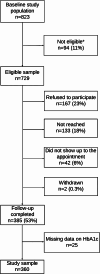Diabetes and prediabetes among women universally screened for gestational diabetes: a multi-ethnic, population-based, prospective study with eleven years follow-up
- PMID: 40181282
- PMCID: PMC11969744
- DOI: 10.1186/s12889-025-22493-x
Diabetes and prediabetes among women universally screened for gestational diabetes: a multi-ethnic, population-based, prospective study with eleven years follow-up
Abstract
Background: Gestational diabetes (GDM) is a strong risk factor for later development of diabetes. However, data are scarce on the long-term risk for diabetes or prediabetes diagnosed by HbA1c, in non-selected, multi-ethnic populations universally screened for GDM using the WHO2013 criteria. We aimed to investigate the development of diabetes or prediabetes eleven years after the index pregnancy and identify risk factors in pregnancy or shortly after.
Methods: A population-based cohort study of 360 women with complete eleven years follow-up data for diabetes (HbA1c ≥ 48 mmol/mol) or prediabetesADA (HbA1c 39-47 mmol/mol). Women were enrolled in gestational week 15 and universally screened with an oral glucose tolerance test in week 28. We performed least absolute shrinkage and selection operator (LASSO) regression to identify predictors of future diabetes or prediabetesADA and constructed a nomogram to predict individual risks.
Results: Diabetes or prediabetesADA combined, was found in 26.9%, and the prevalence was slightly higher in previous GDM compared with non-GDM women (35.6% versus 23.5%; p = 0.019). The relative risk (RR) for developing diabetes or prediabetesADA was moderately elevated in GDM compared with non-GDM women (1.4 [1.0, 1.9], p = 0.035). Seven women (1.9%) had diabetes and all of these except for one, had previous GDM. Hence, the crude prevalence was 5.8% among GDM women vs. 0.4% among non-GDM women. The RR for developing diabetes was substantially higher in GDM vs. non-GDM women (14.8 [2.6, 277.1], p = 0.012). PrediabetesADA was found in 25% and the RR for prediabetesADA was not significantly increased for GDM compared to non-GDM women (1.3 [0.9, 1.8], p = 0.143). Among Europeans, 17.0% had diabetes or prediabetesADA, compared to 43.0% among South Asians (p < 0.001) and 34.4% among other ethnicities (p = 0.002). The most significant predictors identified from the LASSO were HbA1c measured in early pregnancy, ethnicity, and a family history of diabetes.
Conclusions: The risk for developing diabetes was low, overall and among GDM women. Still GDM represented a strong risk for diabetes, but not for prediabetesADA. HbA1c early in pregnancy, non-European ethnicity, and a family history of diabetes were the strongest risk factors for developing diabetes or prediabetesADA.
Trial registration: STORK G2 Women and Risk of Diabetes. NCT03870724 (ClinicalTrials.gov). February 27th, 2019.
Keywords: Ethnicity; Gestational diabetes; Type 2 diabetes.
© 2025. The Author(s).
Conflict of interest statement
Declarations. Ethics approval and consent to participate: Both the original Stork G study, and the follow-up study (Unique Protocol ID: 2018/2517) was conducted according to the Helsinki declaration and were approved by the Regional Committee for Medical and Health Research Ethics of South-Eastern Norway. Informed consent was obtained from all the participants and/or their legal guardians. All participants signed study-specific consent forms when included at baseline and at the eleven years follow-up. Consent for publication: Not applicable. Competing interests: The authors declare no competing interests.
Figures






Similar articles
-
High prevalence and significant ethnic differences in actionable HbA1C after gestational diabetes mellitus in women living in Norway.BMC Med. 2022 Sep 23;20(1):318. doi: 10.1186/s12916-022-02515-w. BMC Med. 2022. PMID: 36138475 Free PMC article.
-
Prediabetes and pregnancy: Early pregnancy HbA1c identifies Australian Aboriginal women with high-risk of gestational diabetes mellitus and adverse perinatal outcomes.Diabetes Res Clin Pract. 2021 Jun;176:108868. doi: 10.1016/j.diabres.2021.108868. Epub 2021 May 21. Diabetes Res Clin Pract. 2021. PMID: 34023341
-
Late-pregnancy dysglycemia in obese pregnancies after negative testing for gestational diabetes and risk of future childhood overweight: An interim analysis from a longitudinal mother-child cohort study.PLoS Med. 2018 Oct 29;15(10):e1002681. doi: 10.1371/journal.pmed.1002681. eCollection 2018 Oct. PLoS Med. 2018. PMID: 30372451 Free PMC article.
-
Diagnostic accuracy of glycated hemoglobin for gestational diabetes mellitus: a systematic review and meta-analysis.Clin Chem Lab Med. 2019 Sep 25;57(10):1435-1449. doi: 10.1515/cclm-2018-1191. Clin Chem Lab Med. 2019. PMID: 30893053
-
Postpartum diabetes mellitus among patients with early gestational diabetes: A systematic review and meta-analysis.J Diabetes Complications. 2025 Jun;39(6):109038. doi: 10.1016/j.jdiacomp.2025.109038. Epub 2025 Apr 8. J Diabetes Complications. 2025. PMID: 40239469
References
-
- Bellamy L, Casas J-P, Hingorani AD, Williams D. Type 2 diabetes mellitus after gestational diabetes: a systematic review and meta-analysis. Lancet. 2009;373(9677):1773–9. - PubMed
MeSH terms
Substances
Associated data
LinkOut - more resources
Full Text Sources
Medical
Research Materials

